The Data Product Pyramid aligns data initiatives with business goals, driving measurable ROI. Discover how our framework transforms data into actionable insights and strategic advantages.
In today’s data-driven environment, the concept of Data Products have emerged as a pivotal element in harnessing the full potential of business analytics to drive meaningful value. This article aims to recalibrate the definition of Data Products to emphasize their business impact, propose a structured framework for their development, and prepare organizations for agile, informed decision-making processes. This shift from technical to strategic focus highlights the evolving role of data as a cornerstone of business innovation.
Traditional data management practices often isolate data handling from core business strategies, which can lead to misaligned objectives and underutilized data assets. To combat this, we propose a business-centric approach to Data Products that ensures alignment with the strategic needs of the company and transforms raw data into actionable insights.
Data Products must be developed with clear business objectives in mind, ensuring they address specific strategic questions and contribute directly to business goals. For instance, a retail company may create a Data Product to analyze customer purchasing patterns to optimize inventory management. This alignment ensures that the Data Product directly supports the company’s goal of reducing stockouts and overstock situations, thereby improving customer satisfaction and reducing costs.
Moving beyond simple data reporting, Data Products should provide actionable recommendations that can directly influence decision-making processes. For example, a predictive maintenance Data Product for manufacturing equipment might analyze sensor data to forecast potential failures, allowing maintenance teams to address issues before they cause downtime. This proactive approach not only enhances operational efficiency but also extends the lifespan of equipment.
Each Data Product should be designed to address a distinct business challenge, equipped with specific metrics to measure its impact and effectiveness. A financial services firm might develop a Data Product to identify fraudulent transactions in real-time, employing machine learning algorithms to detect anomalies and flag suspicious activities. By focusing on this specific challenge, the Data Product provides a targeted solution that enhances security and reduces financial losses.
The Data Product Pyramid offers a structured approach to develop and deploy Data Products that address complex business challenges incrementally.
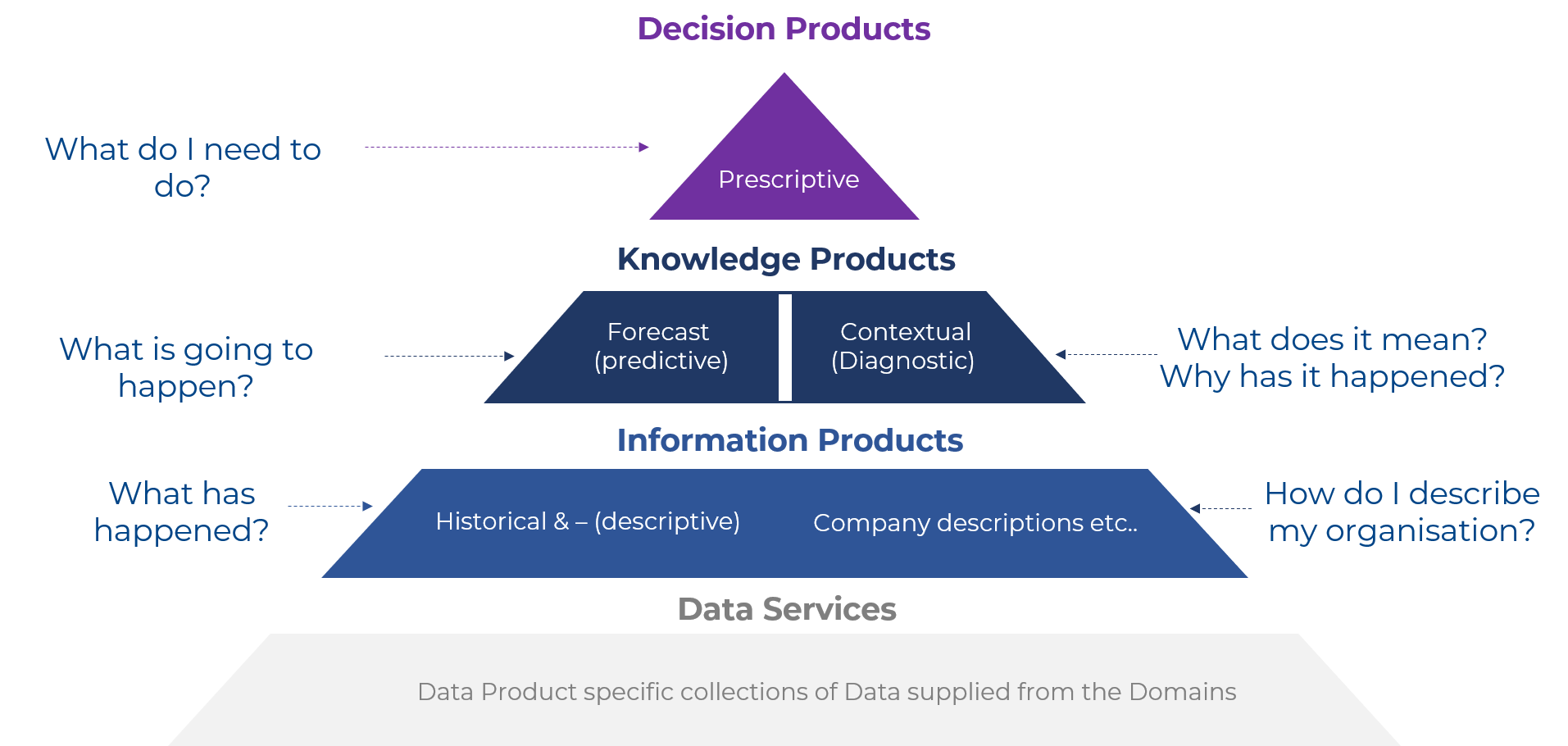
This model organizes Data Products across different levels, each layer building upon the insights and data provided by the previous one, thereby enabling a comprehensive analysis of business problems. The pyramid starts with foundational data services, progresses through information products, and culminates in decision products that directly inform strategic actions.
For instance, a company might start with foundational data services that aggregate sales data across various regions (the base layer). The next level could involve information products that analyze this data to identify trends and patterns. The top level would consist of decision products that recommend specific actions, such as increasing marketing efforts in underperforming regions.
The pyramid levels are composed of different types of products, each solving a specific piece of the puzzle with a distinct approach and purpose:
By adopting an incremental approach, organizations can rapidly prototype, test, and refine Data Products, thereby reducing time-to-market and enhancing the ability to adapt to new information or changing business conditions. This method allows for early wins and continuous improvement, making the development process more agile and responsive.
For example, an e-commerce company might initially develop a Data Product to analyze website traffic patterns (initial prototype). Based on user feedback and performance, the product can be refined to include more granular insights, such as the effectiveness of different marketing campaigns, before finally evolving into a comprehensive recommendation engine that personalizes the shopping experience for each visitor.
The pyramid allows for continuous feedback from business users at each level, ensuring that Data Products remain relevant and are iteratively improved based on actual business needs and user experiences. Regular feedback loops facilitate a deeper understanding of user requirements and help in fine-tuning the Data Products to better serve their intended purpose.
For instance, a healthcare provider developing a patient management system can use feedback from doctors and nurses to enhance the product’s functionality, ensuring it meets the practical needs of healthcare professionals and ultimately improves patient care.
Successful implementation of a Data Product strategy requires a clear process that integrates business needs with data capabilities. This involves a structured approach that ensures each Data Product is aligned with strategic business goals and delivers actionable insights.
The starting point for the process is reacting to business change drivers. These are summarized into three areas:
The Value Framework helps organizations prioritize Data Products based on their potential business impact, ensuring resources are allocated to initiatives that offer the highest return on investment. A structured value framework aligns data initiatives with business objectives, facilitating strategic decision-making and resource allocation.
For example, a telecommunications company might use a value framework to prioritize the development of a customer churn prediction model over other potential projects, given the high impact of retaining customers on overall profitability.
A flexible, iterative development process allows teams to experiment and iterate on Data Products quickly. This agility is crucial for adapting to findings and evolving market conditions. The adaptive implementation process involves rapid prototyping, user testing, and continuous refinement, ensuring that the final product meets the dynamic needs of the business.
For instance, a logistics firm might develop a prototype for optimizing delivery routes based on real-time traffic data. By iterating on the prototype based on driver feedback and real-world performance, the firm can enhance the product’s accuracy and reliability, leading to more efficient operations.
A solid Data Product Foundation provides the necessary technological and organizational infrastructure to develop, deploy, and manage Data Products efficiently. This foundation should support a diverse range of data sources and analytical tools, facilitating seamless integration and scalability.
For example, a multinational corporation might establish a robust data infrastructure that includes cloud storage solutions, data lakes, and advanced analytics platforms. This infrastructure enables different business units to develop and deploy Data Products that leverage shared resources and insights, fostering collaboration and innovation across the organization.
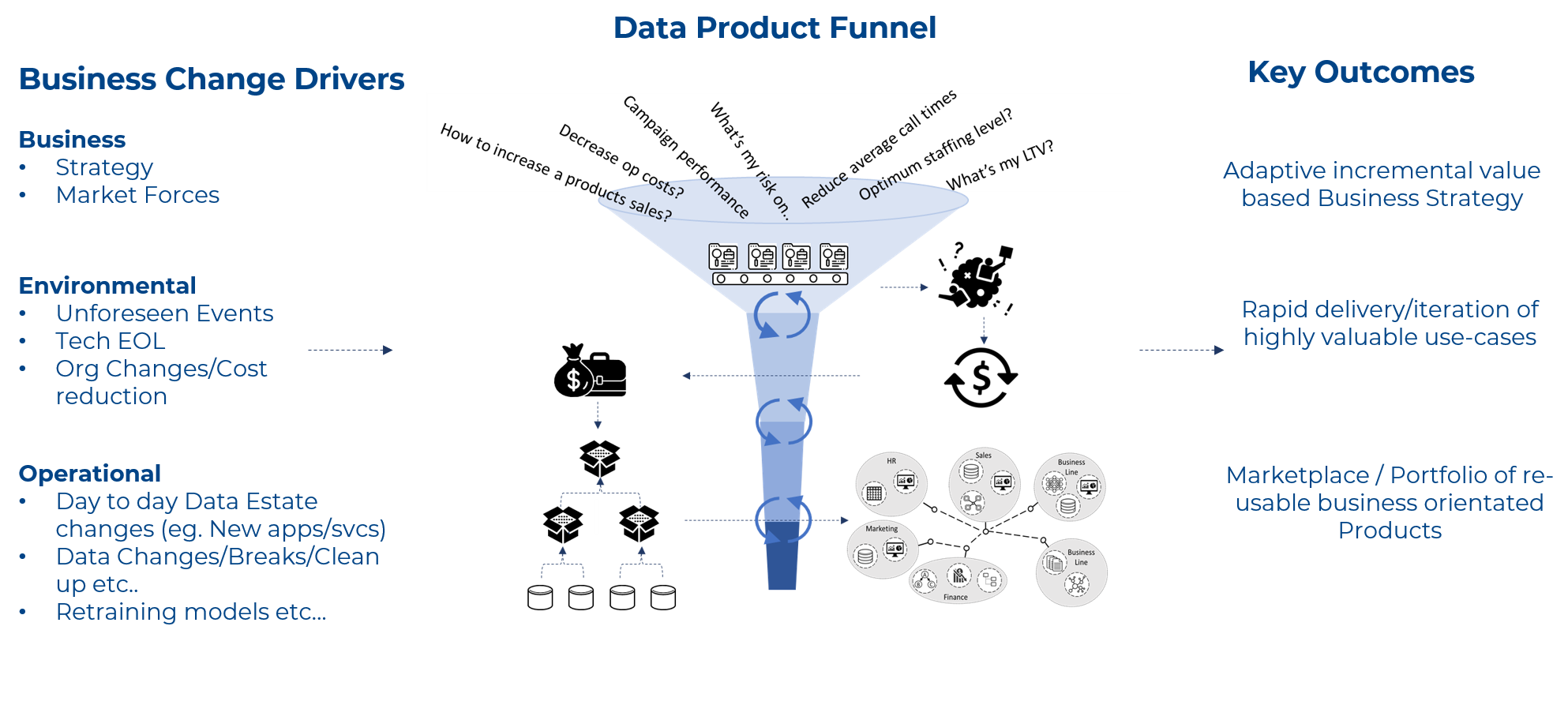
The Data Product Funnel is a process used to implement Data Products to address business changes. This structured approach allows for the incremental development of Data Products, ensuring flexibility and continuous improvement.
So we know what we need to deliver (the pyramid) and we know how it fits into a strategy, but how do we implement this?
We break implementation capability into three parts, all executed as an iterative cycle:
The Value Framework enables the business strategy to be incrementally defined based on actual value and links the business vision and aspirations to the deliverables. It breaks down into:
This iterative way of quickly creating and refining Data Products for each decision/use-case breaks down into:
This is the data infrastructure and development capability for building and deploying Data Product software and data artifacts. It breaks down into:
It is important to note the highly experimental and iterative nature of the early parts of the process. Data Products can be created in very rough form to garner feedback from a business initiative and get more mature as they are tested and refined.
Finally, once they have shown to be fit for purpose, they can be tagged as "production" ready and published as such on the infrastructure.
Data Products can have long life-cycles (e.g., quarterly reports) or short-lived ones (e.g., ad-hoc research for an imminent business event). They can all be created and retired easily as the business changes.
Also, it is important that any type of Data Product is supported. Data Products that need high operational profiles (e.g., real-time recommendation engines) can be published on the Data Foundation alongside those with low profiles (e.g., ad-hoc market research reports). Products can be real-time/batch or have any other type of operational profile, as the business does not distinguish between them.
For this approach to work in large, complex organizations, the process and supporting foundation needs to support Data Products being owned, built, and run by teams in different areas of the business (referred to as Domains).
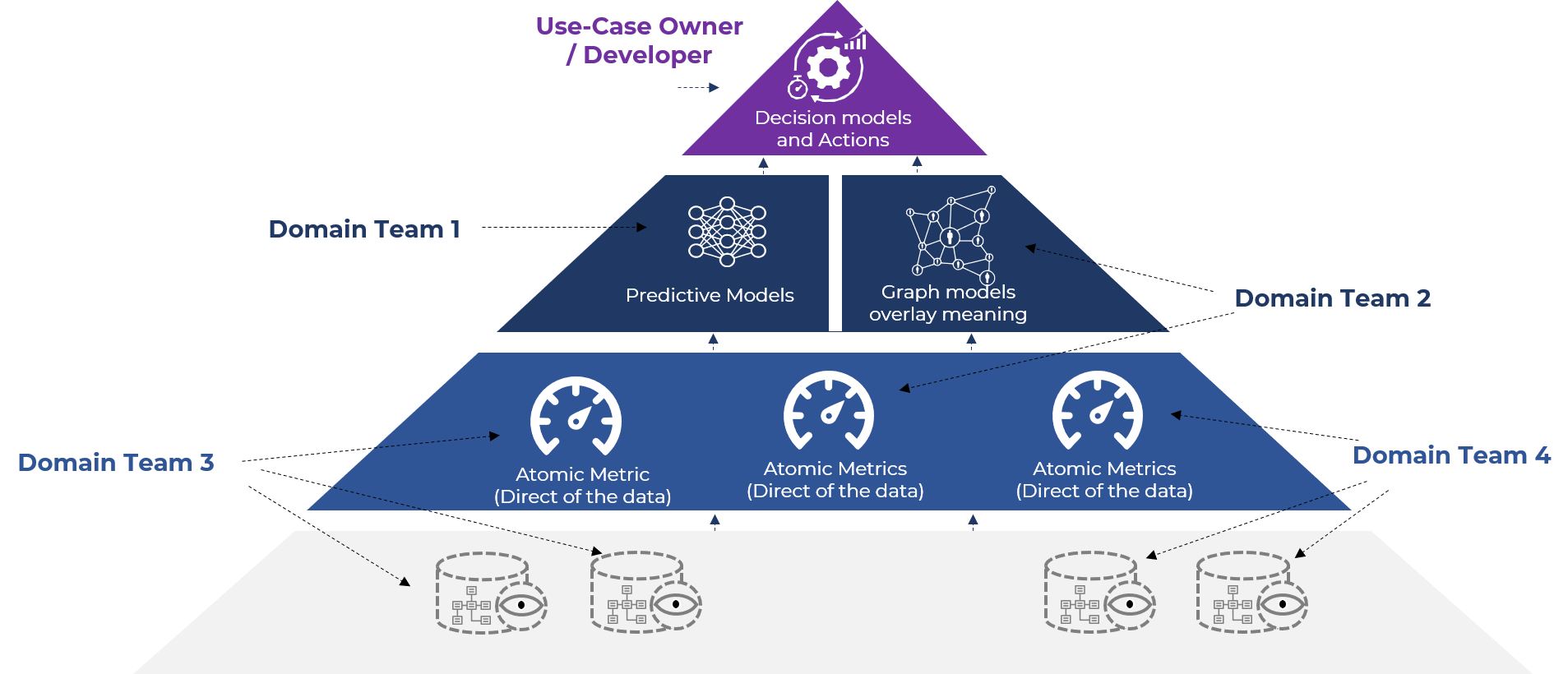
In this example, the data team member charged with the top-level use-case only builds the top-level decision product. They liaise with four other domain teams to build each of the different products and services to form the pyramid.
It is important that the work for each product is carried out by the team that owns that part of the requirement. The Data Product should be delivered directly by the team that owns the business process that delivers that insight or data.
If we follow this process, we achieve the following outcomes:
The following diagram illustrates a structured approach to translating business requirements into actionable Data Products. It outlines the key questions that need to be addressed at each stage of the decision-making process and links them to the corresponding types of Data Products.
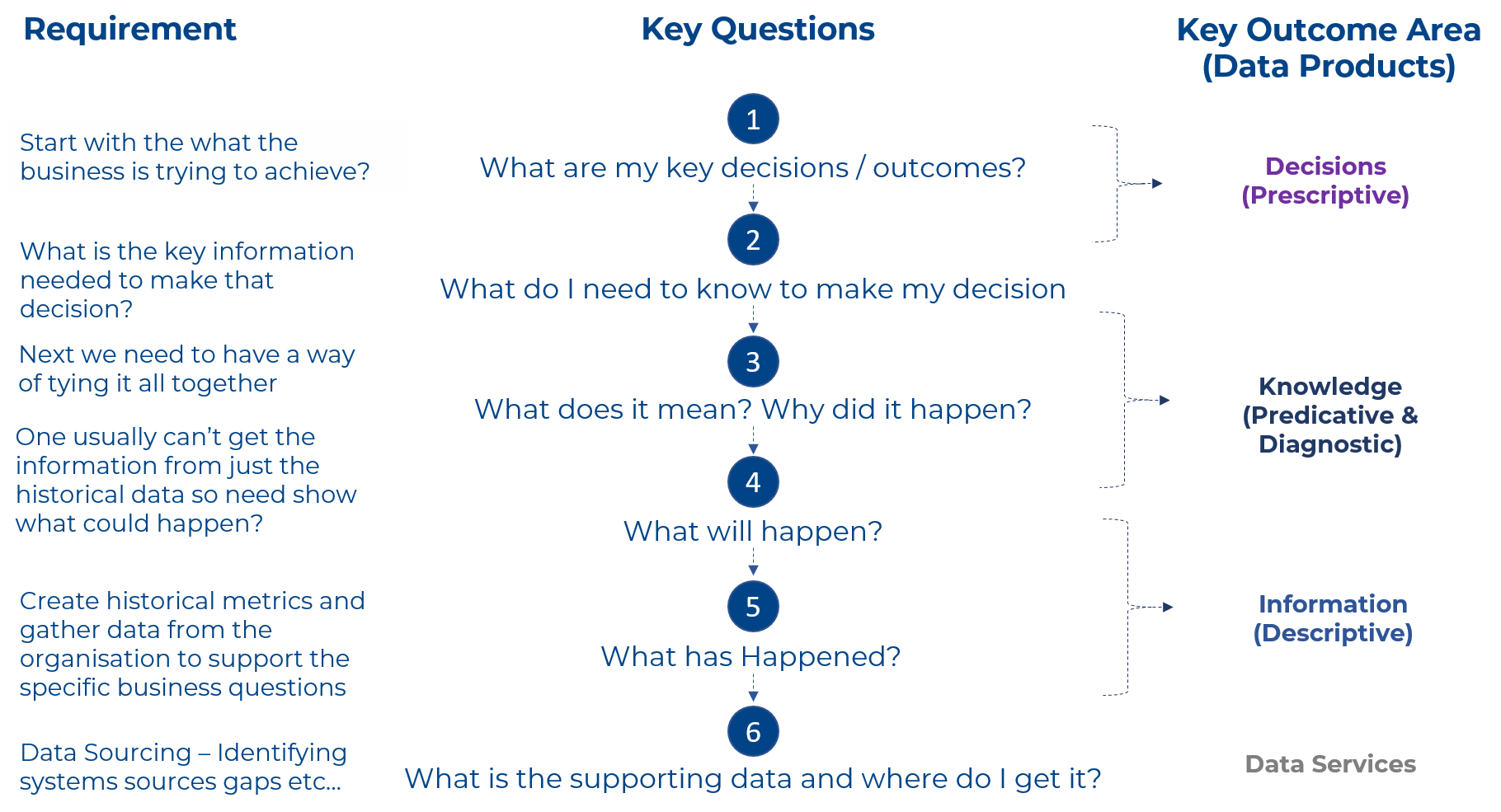
This process involves several steps:
Consider a scenario in which a company aims to reduce its operational costs. The strategy might involve:
Determining which aspects of operations contribute most to costs and identifying potential areas for savings. Key metrics might include energy consumption, labor costs, and equipment maintenance expenses. By establishing clear metrics, the company can focus its efforts on the most impactful areas.
Creating specific tools that predict future costs under various scenarios and recommend actions to reduce costs. For instance, a Data Product might use machine learning algorithms to forecast energy usage based on historical data and recommend optimal scheduling of high-energy activities to minimize costs.
Continuously refining these tools based on real-world performance and changing operational conditions to ensure they remain effective and relevant. This iterative process involves regular reviews and updates to the Data Products, ensuring they adapt to new data and evolving business needs.
For example, a manufacturing company might initially develop a Data Product to monitor and analyze energy usage patterns. Based on the insights gained, the product can be refined to include predictive capabilities and automated recommendations for energy-saving actions, ultimately leading to significant cost reductions.
To solidify this concept, let's work through a detailed example. Imagine the head of Operations has set a goal to reduce operational costs across all business areas.
Setting the Decision: The primary decision is to lower operational costs. This decision would be agreed upon as a priority using the Value Framework.
Key Questions: We need to identify what information is necessary to make this decision, which leads to questions like:
Drilling Down: These questions further break down into more specific inquiries, such as:
Data Sources: The answers to these questions derive from various data sources:
Each of these questions is addressed by a pyramid of Data Products and Data Services, building on each layer to provide comprehensive answers.
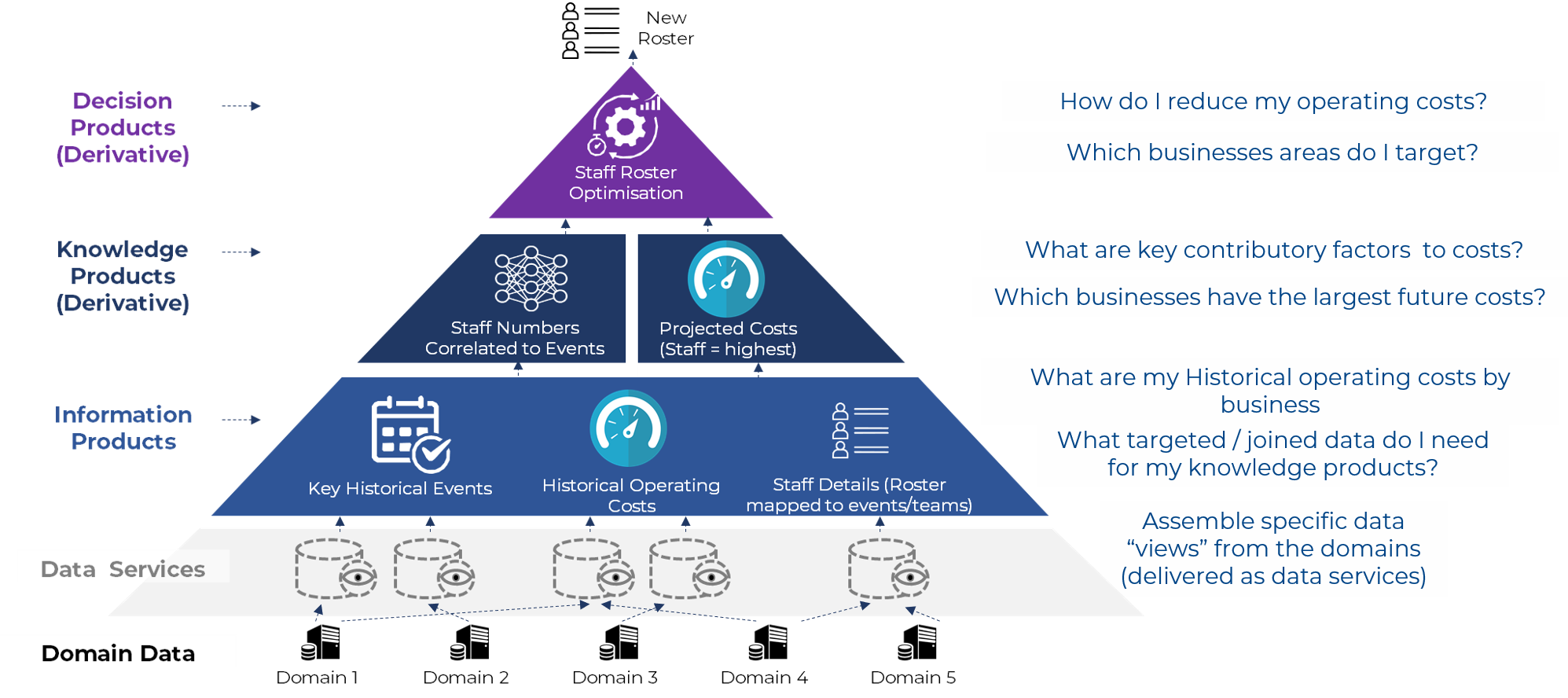
This example demonstrates how each layer of the Data Product Pyramid builds upon the previous one to answer specific business questions, ultimately supporting the top-level decision to reduce operational costs.
This advanced approach to Data Products positions data at the heart of business strategy, enabling organizations to leverage their data assets not just for insight, but for actionable intelligence that drives competitive advantage. By aligning Data Products with business outcomes, companies can transform data from a passive asset into a dynamic tool for strategic decision-making.
Implementing a Data Product strategy involves a structured approach that integrates business needs with data capabilities, facilitates rapid development and iteration, and ensures continuous feedback from business users. Through this iterative and flexible methodology, organizations can develop a robust portfolio of Data Products that drive tangible business value and foster a culture of innovation.
Discover how our structured approach can benefit your business. Reach out for more details.
Explore our Services Contact Us Today